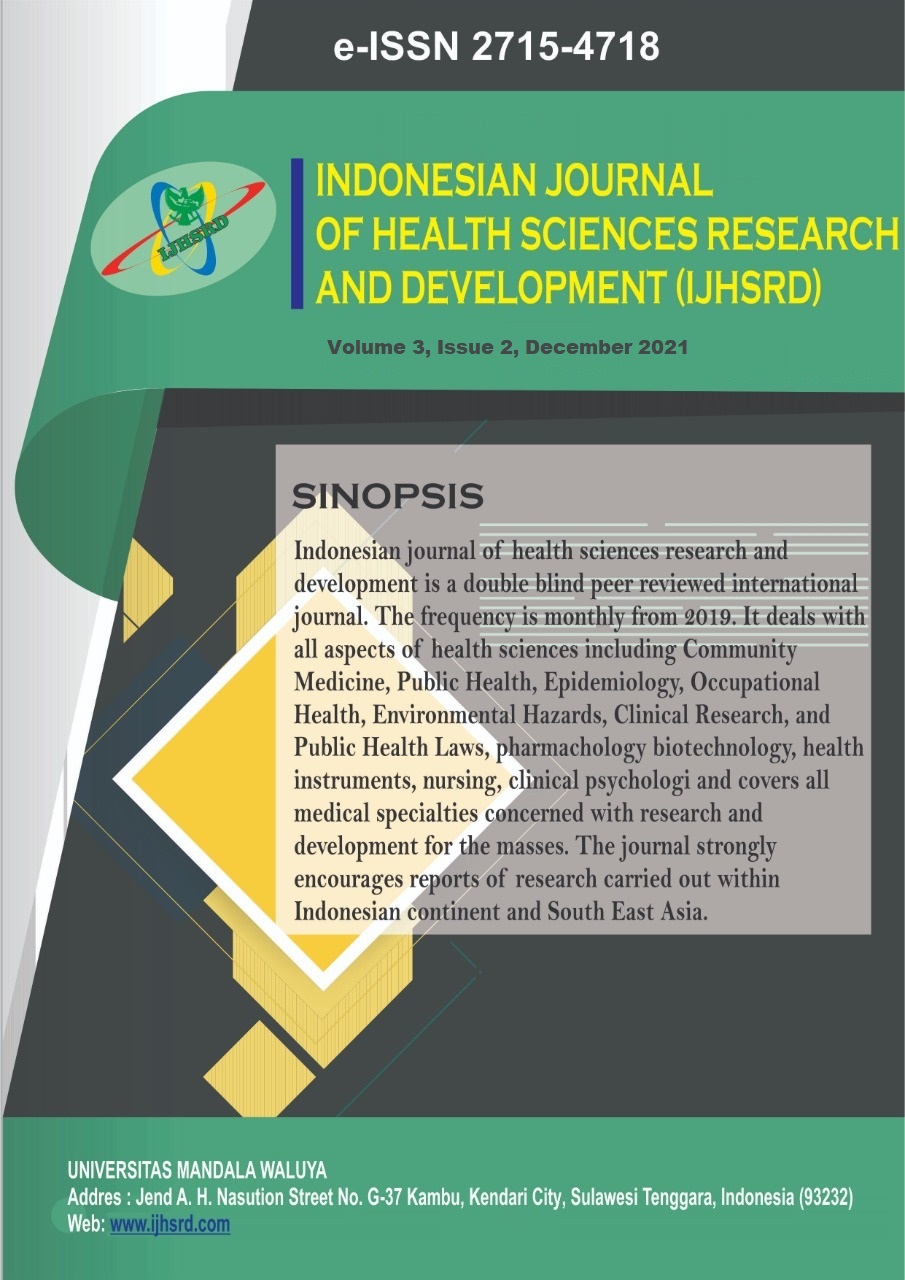Main Article Content
Abstract
Background: An increase in the proportion of the elderly tends to be followed by an increase in health problems caused by degenerative processes. Data from the Kolaka District Health Officein 2019 the number of elderly was 14,440 and those who received health services were 3,547 (24.6%).The low level of health services for the elderly is caused by several factors. This research aims to analyzing the relationship between elderly behavior and compliance with visiting the Posyandu for the elderly in terms of health belief model theory in the Pomalaa Health Center area, Kolaka Regency.
Methods: This type of research is a cross sectional study conducted from March to April 2021,the sample used are 256 respondents taken by simple random sampling.
Result: Using Chi Square Test. The perceived value of vulnerability isX2count = 26,095 > X2table = 3.841, the value of perception of seriousness is X2count = 34,132 > X2table = 3.841, the value of perceived benefit is X2count = 47,026 > X2table = 3.841, the value of perceived obstacle isX2count = 83,542 > X2table = 3.841, the value of intention isX2count = 15.252 > X2table = 3.841.
Conclusion: There is a relationship between perceptions of vulnerability, seriousness, benefits, barriers, and intentions with compliance with visiting the elderly at the elderly posyandu in the Pomalaa Health Center area, Kolaka Regency.
Keywords
Article Details

This work is licensed under a Creative Commons Attribution-ShareAlike 4.0 International License.
References
- United Nations. World Population Prospect: The 2015 Revision [Internet]. 2015 [cited 2021 Feb 16]. Available from: http://www.un.org/en/development/desa/population/ publications/pdf/ageing/WPA2015_Report.pdf
- National Institute on Aging. World's Older Population Grows Dramatically [Internet]. 2016 [cited 2020 Feb 16]. Available from: https://www.nih.gov/news-events/news-releases/worlds-older-population-grows-dramatically
- Central Agency Statistics. Elderly Population Statistics 2020. Jakarta: Central Bureau of Statistics; 2021.
- Indonesian Ministry of Health. Basic Health Research. Jakarta: Indonesian Ministry of Health; 2018.
- Central Agency Statistics. Statistics of Senior Citizens 2019. Kendari: Central Bureau of Statistics; 2020.
- Southeast Sulawesi Provincial Health Office. Health Profile of Southeast Sulawesi Province 2019. Kendari; 2020.
- Notoatmodjo S. Health Research Methods. Jakarta: Rineka Cipta; 2014.
- Sugiyono. Quantitative, Qualitative, and R&D Research Methods. Bandung: Alphabeta; 2019.
- Abeli Health Center. Health Profile of Abeli Health Center 2019. Kendari; 2020.
- Hermawan I. Educational Research Methodology: Qualitative, Quantitative, and. Mixed Method. Brass: Hidayatul Quran; 2019.
- Belcher L, Sternberg MR, Wolitski RJ, Halkitis P, Hoff C, Study Team SUM. Condom use and perceived risk of HIV transmission among sexually active HIV-positive men who have sex with men. AIDS Education & Prevention. 2005;17(1):79–89.
- Muflikhah HM, Widjanarko B, Sugihantono A. Factors Related to the Utilization of the Elderly Posyandu in Bulusan Village, Tembalang District, Semarang City. Journal of Public Health (Undip). 2016;4(5):309–315.
- Prihatiningsih A. Factors Related to Utilization of Posyandu for the Elderly (Case Study in Work Area 6 Public Health Center Semarang City) [Thesis]. [Semarang]: Diponegoro University; 2020.
- Great G, Great A. The low proportion of contacts who make early detection of pulmonary tuberculosis at Puskesmas I South Denpasar in 2012. Public Health and Preventive Medicine Archive. 2013;1(1):55–62.
- Notoatmodjo S. Science & Art of Public Health. Jakarta: Rineka Cipta; 2014.
- Yenita S. Determinant Factors in the Selection of Childbirth Assistance Personnel in the Work Area of Desa Baru Health Center, West Pasaman Regency in 2011 [Thesis]. [Padang]: Andalas University; 2011.
- Lestari IA. Factors related to premarital sexual behavior in Unnes students. Unnes Journal of Public Health. 2014;3(4):27–38.
- Glanz K, Rimer BK, Viswanath K. Health Behavior and Health Education: Theory, Research, and Practice. San Francisco: John Wiley & Sons; 2008.
- Jayadipraja EA, Prasetya F, Azlimin A, Mando WOSY. Family clean and healthy living behavior and its determinant factors in the village of Labunia, Regency of Muna, Southeast Sulawesi Province of Indonesia. Public Health of Indonesia. 2018;4(1):39–45.
- Binita AM, Istiarti VT, Widagdo L. The Relationship of Smoking Perception with Smoking Behavior Types in “X” Vocational High School Students in Semarang City. Journal of Public Health (Undip). 2016;4(5):268–276.
- Wahono H. Analysis of Factors Affecting the Utilization of Posyandu Elderly in Hanging Makamhaji [Thesis]. [Surakarta]: Muhammadiyah University of Surakarta; 2010.
- Ajzen I. From Intentions to Actions: A Theory of Planned Behavior. In: Action controls. Springers; 1985. p. 11–39.
